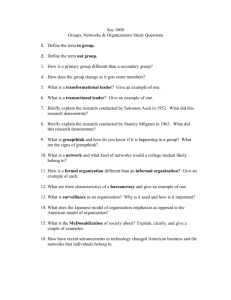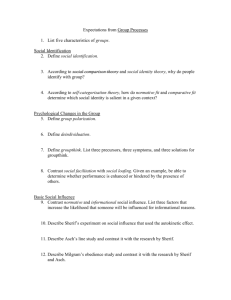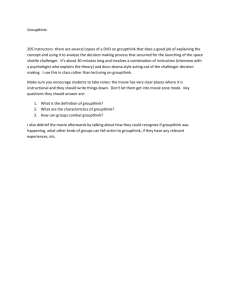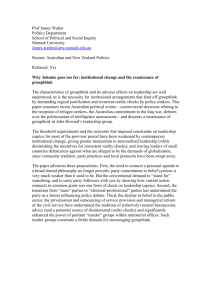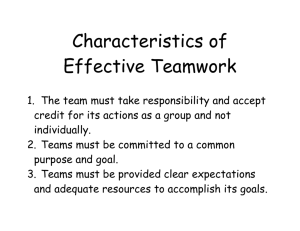Groups, Networks, and Organizations
advertisement
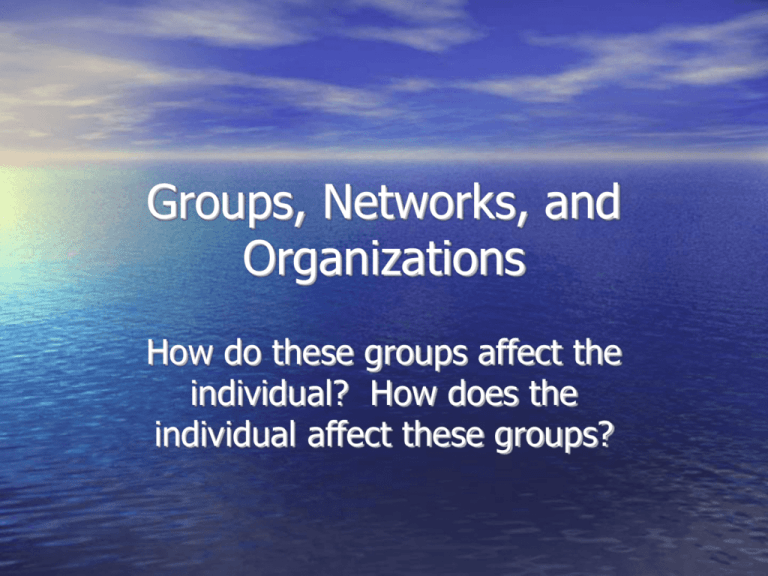
Groups, Networks, and Organizations How do these groups affect the individual? How does the individual affect these groups? Social Groups • Social groups are collections of people who share a sense of common identity and regularity interact with each other on the basis of shared expectations. These social groups shape nearly every experience in our lives. Among the types of social groups there are: – In-groups – groups toward which one feels loyalty and respect – “we” belong – Out-groups – groups toward which one feels antagonism and contempt – “ those” people – Primary groups – includes family, friends, and other peer groups to which one belongs – Secondary groups – are large and impersonal and often involve fleeting relationships; few emotional ties, powerful commitments, or an experience of unity. • Reference groups provide a standard by which we judge ourselves in terms of how we think we appear to others. – Cooley called this the “looking glass self” • Group size affects group dynamics – Small groups are more intimate and have fewer numbers of relationships – Large groups are more stable with far more relationships and complexity – Groups of 12 or more usually have some formal structure – Smallest group is a dyad • Leaders are able to influence other members of the group to what they want – Transactional leaders involves routine leadership concerned with getting a job done – Transformation leaders involve changing the very nature of the group itself – Can you think of examples of each? • Research supports the idea that individuals in the group are highly susceptible to group pressure • Solomon Asch (1952) – Going along with the group – Participants were shown a standard line and then three comparison lines. Their task was simply to say which of the three lines next to the standard line match it. When confederates gave false answers first, 75% of participants conformed by giving the wrong answer. -The participants — the real subject and the confederates — were all seated in a classroom where they were told to announce their judgment of the length of several lines drawn on a series of displays. They were asked which line was longer than the other, which were the same length, etc. The confederates had been prearranged to all give an incorrect answer to the tests. - While most subjects answered correctly, many showed extreme discomfort, and a high proportion (32%) conformed to the erroneous majority view of the others in the room when there were at least three confederates present, even when the majority said that two lines different in length by several inches were the same length. When the confederates were not unanimous in their judgment, subjects were much more likely to defect than when the confederates all agreed. Control subjects with no exposure to a majority view had no trouble giving the correct answer. - One difference between the Asch conformity experiments and the Milgram experiment as carried out by Stanley Milgram (also famous in social psychology) is that the subjects of these studies attributed their performance to their own misjudgement and "poor eyesight", while those in the Milgram experiment blamed the experimenter in explaining their behavior. Conformity may be much less salient than authority pressure. - A number of critiques have been lobbed against Asch's experiment including a question of the motivation of students to be accurate. Rather than testing conformity, Asch's study may have simply measured a disinterested student's reluctance to engage in conflict to get the answer right. Moreover, in Asch's experiments the subjects were not allowed to interact with confederates. When the experiment was conducted in which even one confederate was allowed to give the correct answer, confirming responses dropped significantly. This is consistent with Milgram's later findings of the effect of "role models for defiance" in his classic Obedience Experiment. - Asch's experiment only tested behavioral acquiescence and not attitude change. - Stanley Milgram’s experiment on Obedience to Authority demonstrated that individuals will comply with others even when there is the possibility of harm to themselves or others - The Milgram experiment was a seminal series of social psychology experiments conducted by Yale University psychologist Stanley Milgram, which measured the willingness of study participants to obey an authority figure who instructed them to perform acts that conflicted with their personal conscience. Milgram first described his research in 1963 in an article published in the Journal of Abnormal and Social Psychology, and later discussed his findings in greater depth in his 1974 book, Obedience to Authority: An Experimental View. - The experiments began in July 1961, three months after the start of the trial of Nazi war criminal Adolf Eichmann in Jerusalem. Milgram devised the experiments to answer this question: "Could it be that Eichmann and his million accomplices in the Holocaust were just following orders? Could we call them all accomplices?” - Milgram summed things up in his 1974 article, "The Perils of Obedience", writing: The legal and philosophic aspects of obedience are of enormous importance, but they say very little about how most people behave in concrete situations. I set up a simple experiment at Yale University to test how much pain an ordinary citizen would inflict on another person simply because he was ordered to by an experimental scientist. - Stark authority was pitted against the subjects' [participants'] strongest moral imperatives against hurting others, and, with the subjects' [participants'] ears ringing with the screams of the victims, authority won more often than not. The extreme willingness of adults to go to almost any lengths on the command of an authority constitutes the chief finding of the study and the fact most urgently demanding explanation. - Ordinary people, simply doing their jobs, and without any particular hostility on their part, can become agents in a terrible destructive process. Moreover, even when the destructive effects of their work become patently clear, and they are asked to carry out actions incompatible with fundamental standards of morality, relatively few people have the resources needed to resist authority. - Groupthink – Janis and Mann (1977) identified that members of a group ignore ways of thinking an plans of action that go against the group consensus. - Not only does groupthink frequently embarrass potential dissenters into conforming, but it can also produce a shift in perception so that alternative possibilities are ruled out without being seriously considered. - Groupthink can lead to quick decisions that may not be good ones Groupthink is a type of thought exhibited by group members who try to minimize conflict and reach consensus without critically testing, analyzing, and evaluating ideas. Groupthink may cause groups to make hasty, irrational decisions, where individual doubts are set aside, for fear of upsetting the group’s balance. The term is usually used as a derogatory term after the results of a bad decision. Janis looked at the causes of groupthink. In his book, Victims of Groupthink, he studied several presidents’ foreign policy decisions. He examined the Bay of Pigs invasion, the Cuban missile crisis, and the Korean and Vietnam wars. After examining how these decisions were made, he concluded that there were three main causes of groupthink: 1. Highly cohesive groups are much more likely to engage in groupthink. The closer they are, the less likely they are to raise questions to break the cohesion. 2. The group isolates itself from outside experts. In order to make a well informed decision, the group needs to invite qualified experts to help weigh the possible risks. 3. Strong leadership leads to groupthink, because the leader is more likely to promote his/her own solution. Social psychologist Clark McCauley's three conditions under which groupthink occurs: 1. Directive leadership. 2. Homogeneity of members' social background and ideology. 3. Insulation of the group from outside sources of information and analysis. Symptoms of groupthink In order to make groupthink testable, Irving Janis devised eight symptoms that are indicative of groupthink (197). 1. A feeling of invulnerability creates excessive optimism and encourages risk taking. 2. Discounting warnings that might challenge assumptions. 3. An unquestioned belief in the group’s morality, causing members to ignore the consequences of their actions. 4. Stereotyped views of enemy leaders. 5. Pressure to conform against members of the group who disagree. 6. Shutting down of ideas that deviate from the apparent group consensus. 7. An illusion of unanimity with regards to going along with the group. 8. Mindguards- self-appointed members who shield the group from dissenting opinions. Space Shuttle Challenger disaster (1986) The Space Shuttle Challenger disaster is a classic case of groupthink. The Challenger exploded shortly after liftoff on January 28, 1986 (Vaughan 33). The launch had been originally scheduled for January 22, but a series of problems pushed back the launch date. Scientists and engineers throughout NASA were eager to get the mission underway. The day before the launch an engineer brought up a concern about the o-rings in the booster rockets. Several conference calls were held to discuss the problem and the decision to go ahead with the launch was agreed upon. The group involved in making the Challenger decision met several of the symptoms of groupthink. They ignored warnings that contradicted the group’s goal. - The goal was to get the launch off as soon as possible, and it ended up being a fatal mistake. They also suffered from a feeling of invulnerability, up until that point NASA had an almost spotless safety record. They also failed to completely examine the risks of their decision; they played it off as if it was nothing important. Another factor that had suppressed the few engineers who were "going against the grain" and "sounding the alarm" was that all eyes were on NASA not to delay the launch and that Congress was seeking to earmark large funding to NASA given the large amount of publicity on the Teacher in Space program. These misjudgements led to the tragic loss of several astronauts, and a huge black mark of NASA’s near perfect safety record. • Networks constitute a broad source of relationships, direct and indirect, some of which may be especially important in business and politics. – For example, the poor, individuals of color, and women often have less access to the most influential economic and political networks in society that white men are more likely to have access to. – Is the internet a social network? – Some limitations due to a lack of equal access, the lack of physical proximity but the internet helps to forge new relationships, the relationships can be very stimulating, and involve many shared interests. Organizations • Organizations are groups with an identifiable • • • membership that engages in concerted collective action to achieve a common purpose. Formal organizations are rationally designed to achieve its objectives, often by means of explicit rules, regulations, and procedures Informal organizations may not have explicit rules, regulations, and procedures but may be designed to achieve their own objectives. All modern organizations are, to some extent, bureaucratic. Can you think of examples of modern bureaucracies? • Bureaucracies are characterized by – Having a clearly defined hierarchy of authority – Written rules about the conduct of officials – Separation between tasks of the officials within the organization and life outside of it – Members don’t own the material resources with which they operate – Max Weber theorized about bureaucracies and believed that they were the most effective in organizing large numbers of people • Bureaucracies are supposed to be more efficient • • but seem to be detached and impersonal Informal networks appear to be as important as formal networks both within an organization and between organizations The physical setting of the organization strongly influences their social features. – This includes the architecture of the organization and surveillance of individuals that interact with the organization – Foucault calls surveillance the supervision of activities in organizations. These efforts apply to all members of the organization but especially those on the lower strata of the organization – Prison design it an interesting example (Jeremy Bentham’s Panopticon in 1790) Theory of Surveillance: The PANOPTICON • The PANOPTICON was proposed as a model prison by Jeremy Bentham (1748-1832), a Utilitarian philosopher and theorist of British legal reform. • The Panopticon ("all-seeing") functioned as a round-theclock surveillance machine. Its design ensured that no prisoner could ever see the 'inspector' who conducted surveillance from the privileged central location within the radial configuration. The prisoner could never know when he was being surveilled -- mental uncertainty that in itself would prove to be a crucial instrument of discipline. • French philosopher Michel Foucault described the implications of 'Panopticism' in his 1975 work Discipline & Punish: The Birth of the Prison -- Theories of Organizations • Max Weber identified the tension between the organizing forces of centralizing power in the bureaucracy and the expanding pressures in society of democracy. • Can you think of examples? Gender and Organizations • It is clear that modern society has divisions • • • • within it for men and for women Often, women occupy occupations that support the careers of men More women have advanced into the professions occupied by men but have used the same management styles that men have to make their advances Can you think of how men and women have been treated differently in organizations? Are there alternatives to bureaucracy? Alternatives • Efforts to increase the flexibility of organizations • Adopting Japanese styles of management to involve workers lower down in the organization – – – – – Bottom-up decision making Less specialization Job security Group Orientation Merging of work and private lives • Improvements in pay and responsibility that are • • based on seniority. Group rather than individual performance appraisal. Modern use of technology can dramatically change the way that organizations work. The limitation of time and space are challenged. Global Organization • The United Nations is an example of a global organization that involve governmental groups. • There are concerns about the rate of globalization and the difficulties in organizing both governmental and nongovernmental organizations. • What do you think about the “McDonaldization” of society and the world?
